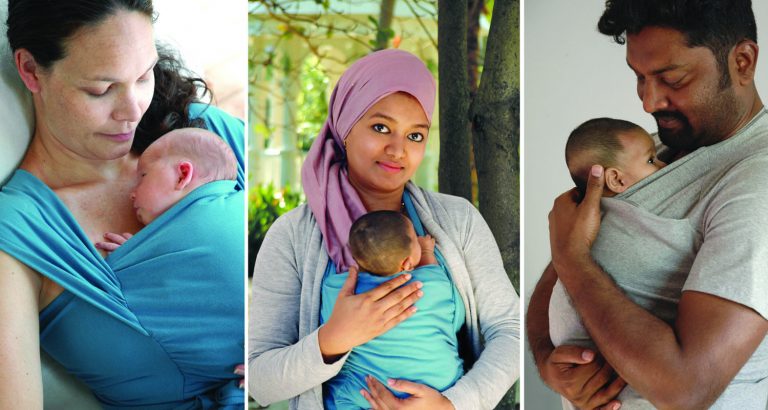In 2003, I was 30 weeks pregnant when I gave birth to my first baby daughter. Like many other moms at the neonatal unit, I had feelings of guilt, incompetence, and helplessness following my preterm delivery. The medical care of the baby, although often necessary, only exacerbated this feeling of incompetence. While mourning the “ideal birth,” like many new moms in these circumstances, I felt like I was losing my bearings.
Early on, I was lucky enough that my baby was stable, so I was “allowed” to hold her on me, skin-to-skin. I felt immediately the natural and instinctive strength of this contact, how it could immediately calm my baby. It also greatly helped me regain the self-confidence I had lost. That is when I learned about what is known as kangaroo mother care, or KMC. Its benefits to her health and development were evident, in addition to mutual comfort and bonding. I started wondering why I had never heard about this.
Since breastfeeding was going smoothly and she was progressing well, the pediatrician allowed me to take her home at only four weeks, though she still weighed only 4.5 lbs (2 kg), on the condition that I continue breastfeeding and give frequent skin-to-skin care.
I was thrilled, but life and all its constraints quickly caught up with me, as there was now less help around me. Despite the great pleasure I had practicing KMC, I found it difficult. I couldn’t just stay seated for skin-to-skin without moving for weeks. I needed to get up and move, but I found that none of the baby carriers were supporting her properly. It was taking a toll on me not being able to eat when I was hungry, drink when I was thirsty, or go to the toilet without waking up this little baby who seemed so desperately in need of this contact.
I then understood how the lack of mobility was a problem, especially during the few weeks after birth, limiting skin-to-skin sessions or shortening the time allocated to it. Other mothers told me that I was lucky it was my first child, saying it was so much worse when there are other children to take care of.
Even as tired as I was, being a designer of functional clothing, I couldn’t keep my brain from working on a solution. You don’t ask a plumber to sit and watch a leaking pipe without doing anything! So for me, it came as a second nature to try to improve KMC, thinking about simple and pretty “feel-good” garments, purposely designed to hold baby skin-to-skin that would also provide, besides safety, more comfort, ease, and mobility, as well as facilitate breastfeeding.
It was a challenge to create such functional clothes. My 25 years of expertise in textiles and clothing design, including 15 years of running industrial manufacturing, certainly came in handy. But first and foremost, I felt it was important to give back to mothers the very real pleasure and the pride of having had a child, even if premature. I wanted to prove that KMC should – and can – be simple, easy, and pleasant.
After several prototypes and many tests, I designed and marketed my first line of breastfeeding and skin-to-skin clothing in 2009, named VIJA Design after a contraction of my name and my daughter’s names (and muses) – Vivianne, Justine, and Anaïs. My “feel-good” garment was the 3-in-1 Skin-and-Skin Kangaroo T-shirt, which holds the baby “hands-free” safely and is easy and fun to use.
I also introduced some specific products adapted to the medical environment, following the request of a paediatrician who loved my concept and thought it would really help getting more skin-to-skin and more breastfeeding at their hospital (Baby-Friendly Hospital Initiative).
Two years later, impressed by the growing number of dads requests to get their own “feel-good” kangaroo T-shirt, I accepted and designed the first Men’s Skin-to-Skin Babywearing T-shirt… So it seems that pride was not just a “mom problem”!
It was a success and I deeply felt I was making a difference for the adoption of KMC to many moms and dads.
This is when I received this heart-touching email from a volunteer nurse working in an orphanage in Mozambique, telling me they had a massive influx of low birthweight babies and saw many of them die because of lack of human contact. She asked me to send some of my Skin-to-Skin Kangaroo T-shirts so nurses can save lives while caring for other children.
It deeply touched me so I sent her as many T-shirts as I could. But, deep inside, I thought it was imperfect. My T-shirt was a little too heavy for warm weather and too expensive to send, and too complicated because of different sizes to manage.
So, thinking of her needs, I developed a lightweight “one-size-fits-most” skin-to-skin garment, which can also be worn as undergarment under traditional clothing. It is very soft for the baby (no seams on delicate skin), safe, easy to put on, and gives mobility to mom – as well as pride.
Being at the KC Product Forum in Kigali (aside the 10th International KMC Conference), I got many requests for this garment from African employees (male and female) at the hotel, asking to buy it. So it’s telling me that I was right: all moms and dads around the world are alike and feel the same way!
Simple, safe, easy, comforting, rewarding, and fostering pride: to me this is what KMC is about and I would like to share with other moms. We need to think about it from a mom’s – and a dad’s – perspective in the hopes that KMC will be adopted quickly, universally, and effectively.


